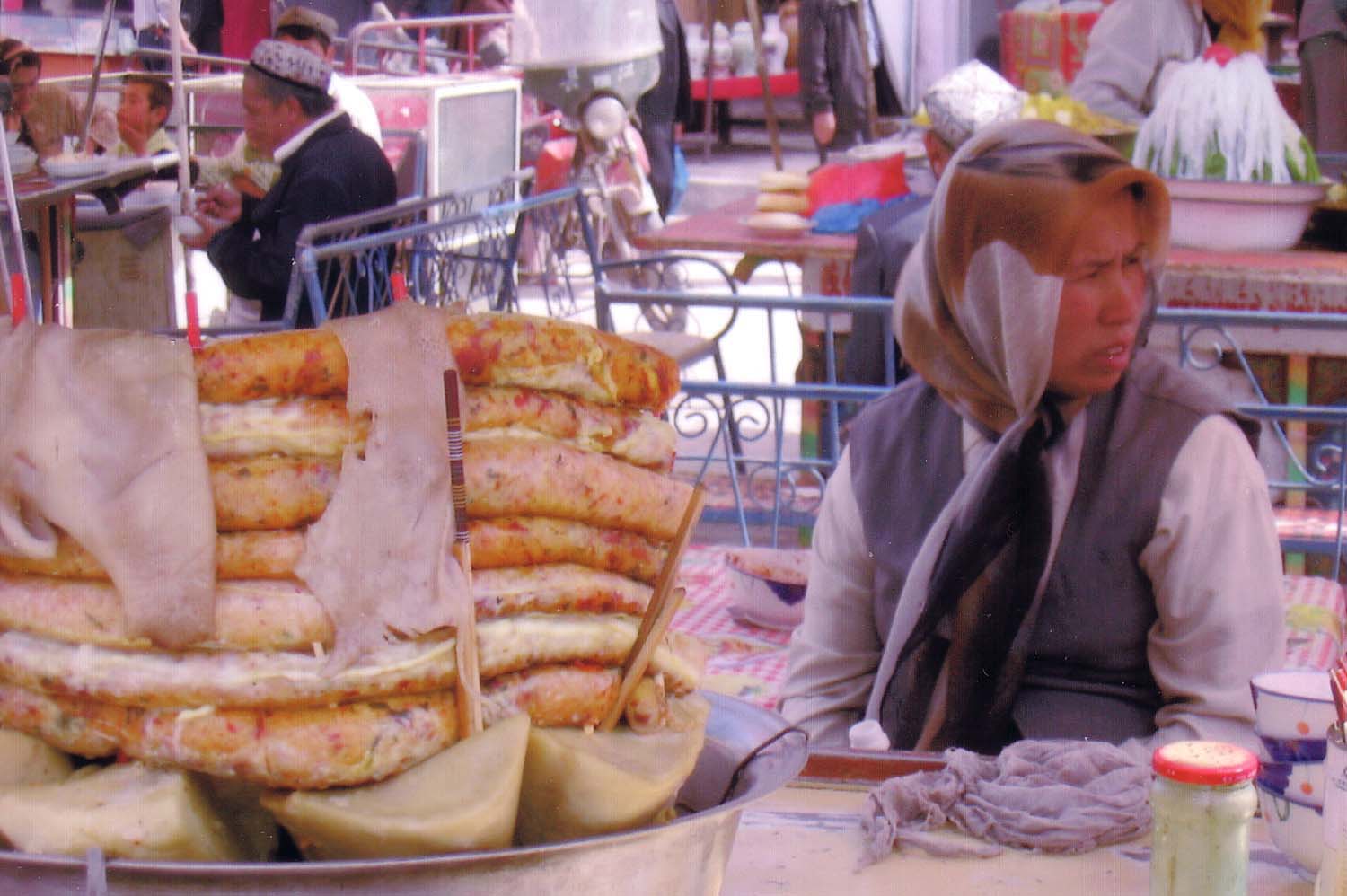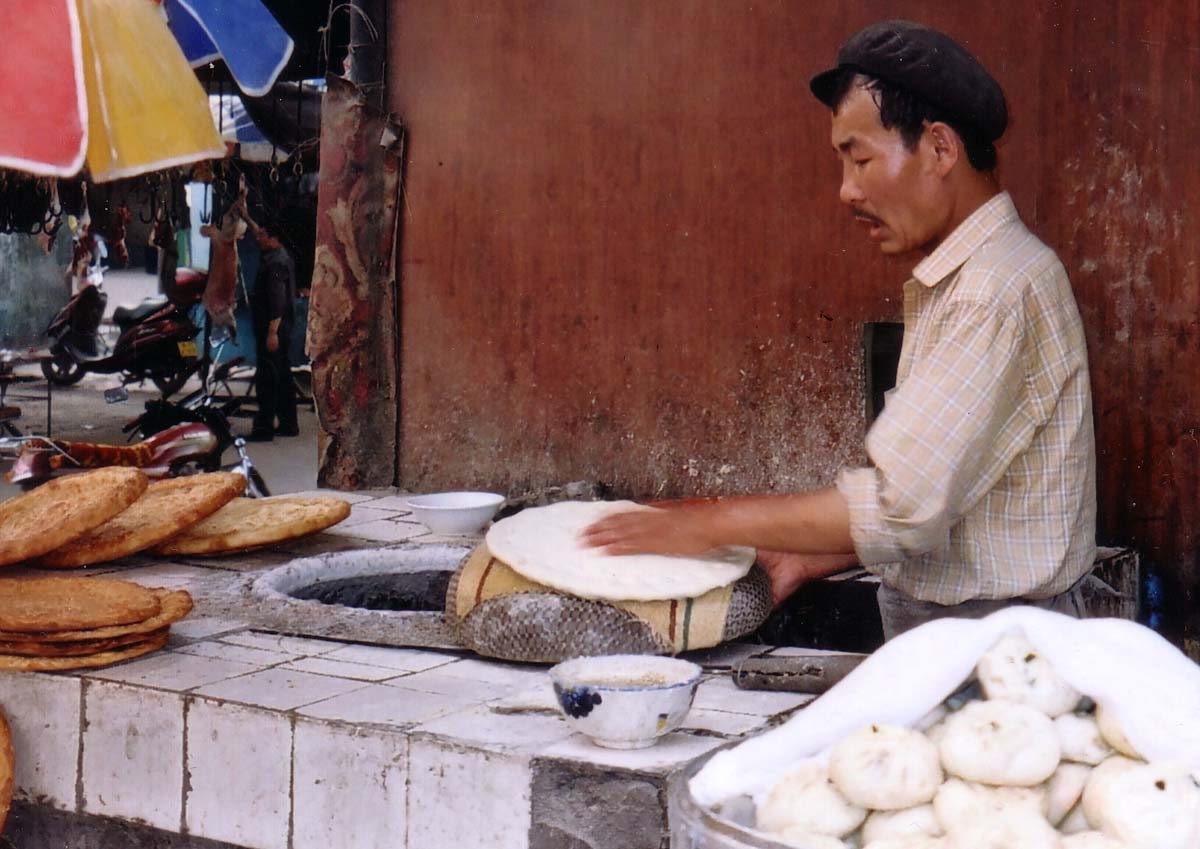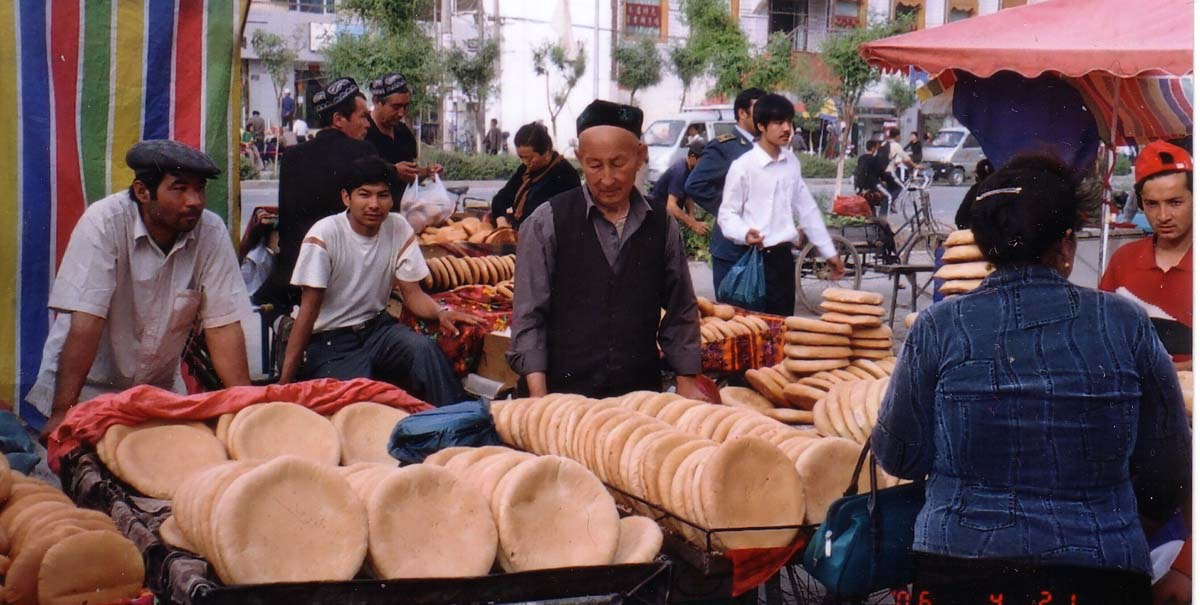
| What is Flavor and Fortune? |
| How do I subscribe? |
| How do I get past issues? |
| How do I advertise? |
| How do I contact the editor? |
Read 12726081 times
Connect me to:
| Home |
| Articles |
| Book reviews |
| Letters to the Editor |
| Newmans News and Notes |
| Recipes |
| Restaurant reviews |
| Article Index (all years, slow) |
| List of Article Years |
| Article Index (2025) |
| Article Index (last 2 years) |
| Things others say |
| Related Links |
| Log In... |
| Authors |
| Categories & Topics |
Eating on the Silk Road
| by Roberta Krakoff |
Chinese Food in China, Hong Kong, and/or Taiwan
Winter Volume: 2006 Issue: 13(4) page(s): 8, and 9
 The Ganzu and Xinjiang provinces comprise both the northern and western most areas of China. They are on the northern leg of China's ancient Silk Road. The foundations of this famous route were laid more than two thousand years ago during the powerful Han Dynasty (202 BCE - 220 CE). At that time, the imperial court at Chang'an, now called Xian, decided to send the emissary Zhang Qiang, to investigate the world to the west. He was to seek potential allies in the ongoing struggle with the nomadic tribes that swept down from the north.
The Ganzu and Xinjiang provinces comprise both the northern and western most areas of China. They are on the northern leg of China's ancient Silk Road. The foundations of this famous route were laid more than two thousand years ago during the powerful Han Dynasty (202 BCE - 220 CE). At that time, the imperial court at Chang'an, now called Xian, decided to send the emissary Zhang Qiang, to investigate the world to the west. He was to seek potential allies in the ongoing struggle with the nomadic tribes that swept down from the north.
The indomitable Zhang returned thirteen years later with only two of the one hundred men he set out with. The others were captured or killed, and he either escaped or was set free on at least two occasions. When he returned he brought no new allies but did bring tantalizing tales of Central Asia, Persia, and parts of the Mediterranean world.
The beginnings of trade were developed later. They were across most inhospitable high mountains and long stretches of desert. This trade brought figs, walnuts, wool, linen, grapes and wine making from the west. In return, China traded jade, porcelain, oranges, peaches, gunpowder, paper, print making, and silk. The last item was a mystery and a rarity in the west. Western folk believed that silk was combed from the leaves of trees; and for many years, China protected the secret of its manufacture. They punished by death, anyone attempting to export silkworms. Nonetheless, the secret did sneak out and silk worms eventually were smuggled out of China in the walking sticks of Nestorian monks.
Ideas, cultural and culinary, moved along the Silk Road. So did the Christianity of the monks. This religion and others were not in favor in the 4th century BCE when Buddhism became the official religion of most of northern China.
Along the Silk Road, Buddhist monasteries, chapels and grottoes were built by wealthy and grateful patrons. The remains of these glorious works are still visible in places such as the Mongao and Bingling Si caves, both of which are in the Ganzu province. Marco Polo, the best known early western explorer, had his Silk Road impressions recorded along with life under the Yuan (Mongol) dynasty. These are in diaries read by many of today's tourists.
 A large number of China's ethnic minorities live in northern China including the Uygur and the Hui peoples. The Uygurs are of Turkic descent and have, for at least one thousand years, been overwhelmingly Muslim. The Hui, said to be descended from Middle Eastern traders who arrived in China about 1000 CE, also follow the teachings of Islam, though theirs are somewhat different ones from those practiced in traditional Muslim countries.
A large number of China's ethnic minorities live in northern China including the Uygur and the Hui peoples. The Uygurs are of Turkic descent and have, for at least one thousand years, been overwhelmingly Muslim. The Hui, said to be descended from Middle Eastern traders who arrived in China about 1000 CE, also follow the teachings of Islam, though theirs are somewhat different ones from those practiced in traditional Muslim countries.
The Hui do not dominate any particular area. They live side by side with the Uygurs in the western towns of Urumqui, Turpan and Kashgar. The religious beliefs of these two groups and the desert topography of the region give their cuisines distinctly different characteristics in Eastern China. Theirs are more like food of Central Asia in taste and in ingredients. Mutton is widely used and unless requested, it is served with bone and gristle included. In fact, most mutton is not trimmed at all.
 This can be seen in open-air butcher shops in markets in small villages, towns, and cities Every part of the animal is used. Skewered heart, lung and kidney are sold at a brisk pace on the streets of Urumqui. In Kashgar, vendors such as the lady pictured with this article, sell boiled lamb intestines stuffed in bread along with spices; both are also in sheep head soup. Mutton, mutton fat, and onions are stuffed in packets of dough, then fried, boiled or steamed depending on the buyer's taste. In another picture with this article, there are some to the right of the man making bread; these are steamed.
This can be seen in open-air butcher shops in markets in small villages, towns, and cities Every part of the animal is used. Skewered heart, lung and kidney are sold at a brisk pace on the streets of Urumqui. In Kashgar, vendors such as the lady pictured with this article, sell boiled lamb intestines stuffed in bread along with spices; both are also in sheep head soup. Mutton, mutton fat, and onions are stuffed in packets of dough, then fried, boiled or steamed depending on the buyer's taste. In another picture with this article, there are some to the right of the man making bread; these are steamed.
Rows of merchants sell these foods prepared in all three varieties, and Kashgar merchants sell plain round baked breads made with wheat flour. Mutton most readily palatable to the western taste is trimmed, seasoned with salt, pepper and cumin, then grilled on small skewers.
Chicken is widely served, too. As with mutton, it comes with all parts, head and feet included. If that is not to a diner's taste, most restaurants will cut the chicken into parts, remove gristle and internal parts and leave out the extremities. Not so when eating on the street; there you take what you get.
In the northwestern provinces of China along the Silk Road/Route, noodles replace rice. There is some showmanship involved in making them in the markets and in the restaurants. The cook or merchant grabs both ends of a long roll of elastic dough, pulls into a long ribbon and then, joins his hands so there two ribbons. Slapping the dough together quickly and often, the strands multiply rapidly resulting in a mass of noodles called la mian, literally meaning pulled noodles. They are served in beef soup alone, with sesame seeds, and with and under various vegetable combinations. Flat bread called nan is served with most meals; it is best eaten while warm. The bread gets hard and loses taste at room temperature and when cold. In markets, men such as the one pictured in the white shirt, can be seen flattening dough on the back of a bowl then putting it into small hot ovens. They make both nan, the round flat bread seen here, and a bagel-like bread. The latter, a good street food snack, is also best hot from the oven.
Despite the fact that about one-third of China, including most of the Xinjiang and Ganzu provinces, is desert, there is an abundance of fruits and vegetables in their marketplaces. Dried fruit is particularly refreshing. It can be purchased from street venders in almost any quantity. Among the most memorable ones were varieties of raisins called 'mare's nipples.' The snow plums, currents, apricots, and dates were also very good.
In one restaurant, as part of the main course, we were served a dish made of sticky rice. It was an exception to the usual no-rice-rule. It arrived embedded with slices of sweet potato and had nuts and prunes in its center. At another restaurant we ate steamed dates and raisins in a slightly sweet sauce as part of the main meal. It was a good compliment to the meat and noodles.
Root and leaf vegetables were plentiful. They are fresh and part of every meal, served alone or with chicken or mutton. At times we skipped meat courses in favor of additional vegetable and noodle dishes. Fish was available from the local lakes and whole carp was served in a rich slightly tangy sauce. Eggs with tomatoes were part of several lunches and dinners, their taste and texture far from mushy.
A word about drinking. Bottled water is, of course, a must. It is sold in most small stores and restaurants. Light local beers make fine accompaniments to virtually every lunch and dinner. Hard liquor is almost unavailable, except in hotels and there is little variety, though wines can be found. We thought the best wine we had was named Dynasty. Second best was the Great Wall brand, and Loulan was a distant third. Soft drinks seemed to be everywhere, sometimes familiar brands and other times not. Juice while tempting, is best left untouched because it may have been mixed with non-bottled water.
The names of local dishes are missing from this article because all menus were in Chinese or Uygur or both. Therefore, we were completely dependent upon our guides to order for us. They did an excellent job respecting our adventuresome spirits and accommodating our sometimes flagging palates.
_____
The author has three plus decades of experience in social work and public health, is an avid traveler, and a keeper of thorough experiences enjoyed on the road including dishes that delight. Though not a 'foodie,' she has a keen eye for fascinating finds. For this article, she extends much gratitude and respect to her traveling companions. Jane identified each ingredient graciously, and Larry and Ray helped try them all.

Copyright © 1994-2025 by ISACC, all rights reserved
Address
3 Jefferson Ferry Drive
S. Setauket NY 11720